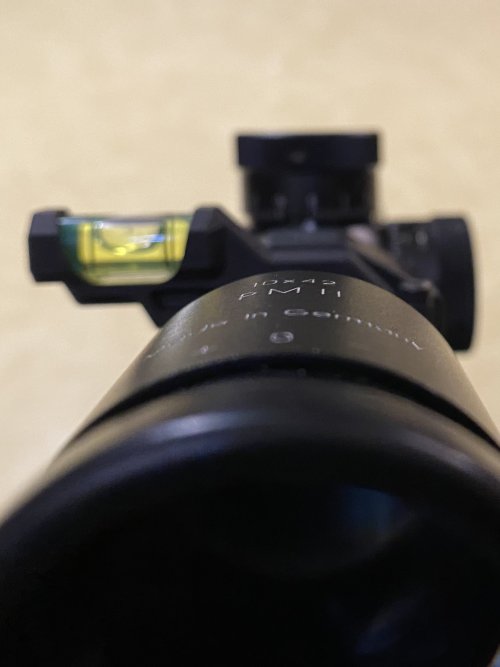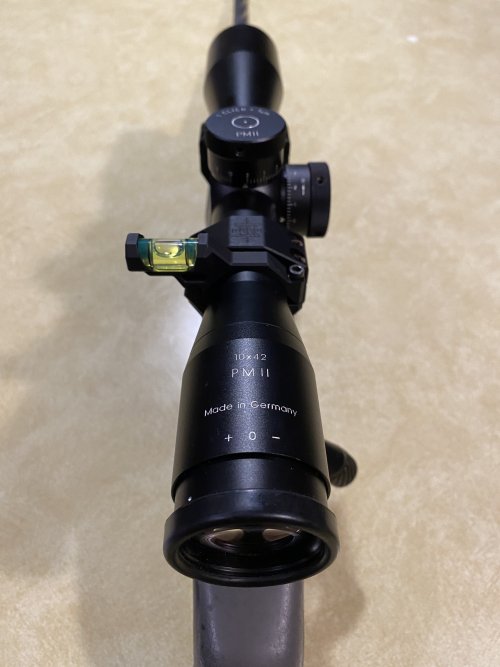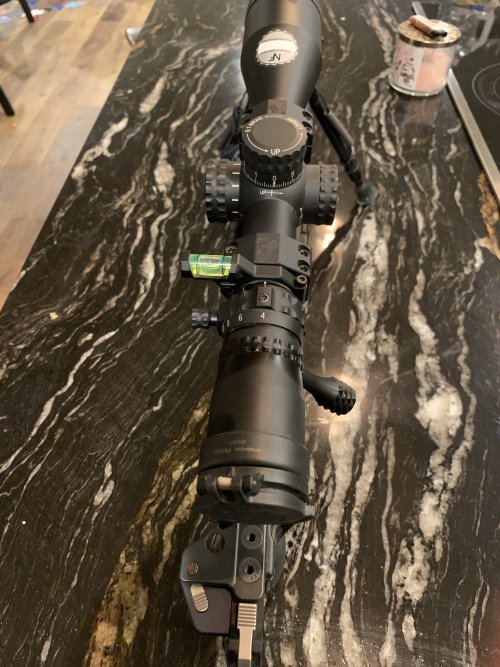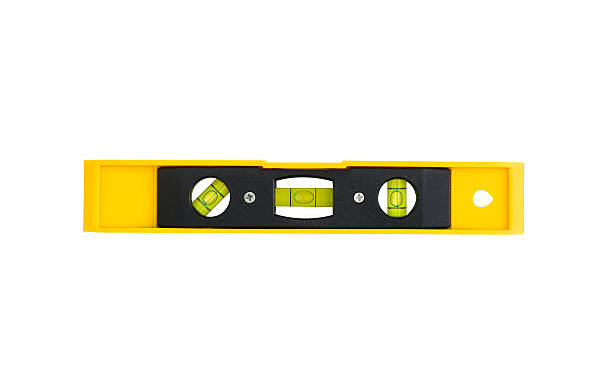Navigation
Install the app
How to install the app on iOS
Follow along with the video below to see how to install our site as a web app on your home screen.
Note: This feature may not be available in some browsers.
More options
You are using an out of date browser. It may not display this or other websites correctly.
You should upgrade or use an alternative browser.
You should upgrade or use an alternative browser.
Rifle scope bubble level reviews
- Thread starter Jjw4413
- Start date
Curious what you mean by "aren't very precise"? If you level the rifle, level the scope, and level the ring as you torque it then it will all be level...which I would argue is precise. You could end up with different ring gaps on either side but that doesn't matter if it's all level.Nightforce and Talley make anticant levels that replace your top scope ring. They aren't very precise but will get you close enough
I have found an issue with the Talley anti-cant indicator rings, which I'm surprised they haven't addressed. I probably have 10 of them and every single one was too big, meaning that the top ring would touch the bottom ring before getting to 15 inch pounds of torque [a way to visualize this is there is zero ring gap on both sides, so you're not getting enough clamping force on the scope tube]. To fix this I grind down the bottom of the ring to create more ring gap on both sides.
Frequently Banned Troll
Well-known member
Thank you for sharing a story about some special needs folks you know. But if the topic is not “relevant” to somebody like you - why do you pollute the thread with your ridiculous bs?Thanks for the link. Very interesting ... but not very relevant for someone like me who's not interested in lobbing bullets at animals on the next planet. The bit about keeping the scope as low as possible to the bore makes sense. I need to send it to my daughter's father-in-law. He showed me his old Remington TargetMaster .22 when I was at his place for Christmas dinner. A local gunsmith had mounted a 1" diameter hunting scope (cheap knockoff imitation of something fancy). I was shocked to see it wearing scope rings of different heights. The rear ring appeared to be "high" and front one probably medium, maybe low. He said it is zeroed but I'm surprised he didn't run out of elevation adjustment. The rings were no name flat finish. Getting on the crosshairs required about 3/4" daylight between my cheek and stock. He actually plans to shoot competition targets (doesn't hunt). I tried to convince him this was a mess (hopefully the scope tube hasn't been dimpled). But of course what do I know ... I'm not a gunsmith like old Cal (recently deceased). I have some retired Weaver 1" medium height rings that I'd be glad to set him up with ... but I don't know anything. He could definitely use low height rings for good cheek weld. Cal obviously just unloaded a bunch of odds and ends stuff on someone who doesn't know anything about guns. e.g.: Brian showed me the BSA .270 Win that's been pounding him to shit at the range. As soon as I looked at it I knew it was not made by BSA. It's a 1917 Springfield with a BSA add-on barrel. The reason it was kicking is it's on a homemade stock with a goofy drop at comb. "No, my dad gave me that gun and it was new from BSA. He told me so." BSA did sell remanufactured military rifles but their work was top shelf (glossy finish, rosewood caps, etc). This was crap. I mean, the checkering on both sides of pistol grip didn't come close to matching and no checkering on fore end. Who knows what kind of wood was used. Not walnut. I had to go on line to finally convince him it was military surplus not factory BSA. Obviously, if a super heavy 1917 in only .270 is beating him up, there must be something seriously wrong with the stock. "Here, you can order a new stock from Boyd's and make that gun a shooter AND a looker. I'll show you how to drop it in the new wood." Nope. I'm not a gunsmith so what do I know. Anyway, after reading that link, I now know a lot more. Thanks again.
Last edited:
Frequently Banned Troll
Well-known member
Another vote for flatline optics. Had my rifle out tonight as I ordered a suppressor finally and was taking some measurements. I do not have to move my head or eyes from sight picture, when aiming to have a clear view of the level, even with my reader glasses needed eyes. Top end machined and only an ounce.




You just torque it with the level in place. Use a torque wrench, then you know everything is torqued evenly. If it's all level then you don't worry about the ring gaps.Getting the top ring concentrically level with the bottom? I have hell using the mount level in my Wheeler kit.
If it keeps pulling the scope out of level as you torque the ring caps then that's a great indicator that your rings are out of alignment and you need to lap them into alignment. Or don't lap them and enjoy the ring marks and headache in getting it level.
millerkiller77
Well-known member
I'm not sure if the liquid is to viscous or what, but you can cant the rifle a few degrees either direction without the bubble moving...Curious what you mean by "aren't very precise"? If you level the rifle, level the scope, and level the ring as you torque it then it will all be level...which I would argue is precise. You could end up with different ring gaps on either side but that doesn't matter if it's all level.
I have found an issue with the Talley anti-cant indicator rings, which I'm surprised they haven't addressed. I probably have 10 of them and every single one was too big, meaning that the top ring would touch the bottom ring before getting to 15 inch pounds of torque [a way to visualize this is there is zero ring gap on both sides, so you're not getting enough clamping force on the scope tube]. To fix this I grind down the bottom of the ring to create more ring gap on both sides.
I've noticed it's a little slow to move, so I kind of agree.I'm not sure if the liquid is to viscous or what, but you can cant the rifle a few degrees either direction without the bubble moving...
He can't help himself. It's like groundhog day.Thank you for sharing a story about some retards you know. But if the topic is not “relevant” to somebody like you - why do you pollute the thread with your ridiculous bullshlt?
Why don't all scope have internal anti cant bubbles?
Shoot at reasonable hunting distances and it’s not an issue.
OntarioHunter
Well-known member
- Joined
- Sep 11, 2020
- Messages
- 5,998
Wow! Grinding on Talley rings to make them fit? For that kind of price tag? I presume all ten scopes aren't the same make so it's not an issue with factory tube diameter.Curious what you mean by "aren't very precise"? If you level the rifle, level the scope, and level the ring as you torque it then it will all be level...which I would argue is precise. You could end up with different ring gaps on either side but that doesn't matter if it's all level.
I have found an issue with the Talley anti-cant indicator rings, which I'm surprised they haven't addressed. I probably have 10 of them and every single one was too big, meaning that the top ring would touch the bottom ring before getting to 15 inch pounds of torque [a way to visualize this is there is zero ring gap on both sides, so you're not getting enough clamping force on the scope tube]. To fix this I grind down the bottom of the ring to create more ring gap on both sides.
Isn't potential alignment issues the reason target shooters go with rails rather than split bases? If the rings are same make and same height, it would seem to be pretty much impossible for them to not be lined up perfectly on a one piece straight rail if the rings are torqued the same. Right?
Last edited:
Frequently Banned Troll
Well-known member
Not on the flatline optics. It expensive but it does what it’s supposed toI'm not sure if the liquid is to viscous or what, but you can cant the rifle a few degrees either direction without the bubble moving...
The Talley anti-cant indicator ring is $30. That’s cheap.For that kind of price tag?
Their rings don’t have the issue without the ACI ring, it’s the ACI ring that has the issue.
OntarioHunter
Well-known member
- Joined
- Sep 11, 2020
- Messages
- 5,998
Ah, I see. Thanks for clearing that up. I was pricing Talley when I was shopping for QD rings and their prices for those seemed more than a bit over the top compared to Burris, Warne, and Leopold.The Talley anti-cant indicator ring is $30. That’s cheap.
Their rings don’t have the issue without the ACI ring, it’s the ACI ring that has the issue.
Elkmagnet
Well-known member
I have this one and it works for me.I put a Talley top scope ring level on my Vanguard .308 Win.
I've never used it hunting, but I practice almost every week shooting at gongs out to 430 yards.
Once the gun is set on the target, you have to slightly raise your head to see the level, then carefully thghten your cheek back on the stock.
I haven't convinced myself to put one on either of my main hunting rifles.

std7mag
Well-known member
I keep shaking my head wondering what the heck some people do to their rifles.
More specifically their scopes.
How the heck do you break off a swiveling bubble level?
I've been using the Caldwell swiveling levels for about 8 years now without issue.
I did pop for a US Optics swiveling bubble that mounts on the rail for one rifle & really like it!
@OntarioHunter
Sounds like your daughters father in law has his rifle cobbled together more towards long range benchrest.
Most of these are set up for "free recoil".
Meaning the only part of the body touching the rifle is their trigger hand. Usually the triggers are light enough that it's only the trigger finger, not the whole hand. There is no cheek weld as on a hunting rifle.
LOP is usually fairly short also.
Dial in elevation.
Fine tuning the placement of the cross hairs on the target is done with the front rest instead of dialing the scope.
More specifically their scopes.
How the heck do you break off a swiveling bubble level?
I've been using the Caldwell swiveling levels for about 8 years now without issue.
I did pop for a US Optics swiveling bubble that mounts on the rail for one rifle & really like it!
@OntarioHunter
Sounds like your daughters father in law has his rifle cobbled together more towards long range benchrest.
Most of these are set up for "free recoil".
Meaning the only part of the body touching the rifle is their trigger hand. Usually the triggers are light enough that it's only the trigger finger, not the whole hand. There is no cheek weld as on a hunting rifle.
LOP is usually fairly short also.
Dial in elevation.
Fine tuning the placement of the cross hairs on the target is done with the front rest instead of dialing the scope.
Thanks for the link. Very interesting ... but not very relevant for someone like me who's not interested in lobbing bullets at animals on the next planet. The bit about keeping the scope as low as possible to the bore makes sense. I need to send it to my daughter's father-in-law. He showed me his old Remington TargetMaster .22 when I was at his place for Christmas dinner. A local gunsmith had mounted a 1" diameter hunting scope (cheap knockoff imitation of something fancy). I was shocked to see it wearing scope rings of different heights. The rear ring appeared to be "high" and front one probably medium, maybe low. He said it is zeroed but I'm surprised he didn't run out of elevation adjustment. The rings were no name flat finish. Getting on the crosshairs required about 3/4" daylight between my cheek and stock. He actually plans to shoot competition targets (doesn't hunt). I tried to convince him this was a mess (hopefully the scope tube hasn't been dimpled). But of course what do I know ... I'm not a gunsmith like old Cal (recently deceased). I have some retired Weaver 1" medium height rings that I'd be glad to set him up with ... but I don't know anything. He could definitely use low height rings for good cheek weld. Cal obviously just unloaded a bunch of odds and ends stuff on someone who doesn't know anything about guns. e.g.: Brian showed me the BSA .270 Win that's been pounding him to shit at the range. As soon as I looked at it I knew it was not made by BSA. It's a 1917 Springfield with a BSA add-on barrel. The reason it was kicking is it's on a homemade stock with a goofy drop at comb. "No, my dad gave me that gun and it was new from BSA. He told me so." BSA did sell remanufactured military rifles but their work was top shelf (glossy finish, rosewood caps, etc). This was crap. I mean, the checkering on both sides of pistol grip didn't come close to matching and no checkering on fore end. Who knows what kind of wood was used. Not walnut. I had to go on line to finally convince him it was military surplus not factory BSA. Obviously, if a super heavy 1917 in only .270 is beating him up, there must be something seriously wrong with the stock. "Here, you can order a new stock from Boyd's and make that gun a shooter AND a looker. I'll show you how to drop it in the new wood." Nope. I'm not a gunsmith so what do I know. Anyway, after reading that link, I now know a lot more. Thanks again.
You make my head hurt….
noharleyyet
Well-known member
D
Deleted member 16014
Guest
Half a bubble off, in the parlance of the thread…You make my head hurt….
OntarioHunter
Well-known member
- Joined
- Sep 11, 2020
- Messages
- 5,998
It's only a .22. It has a cheapo imitation long range scope on it (turrets), but I don't think he'll be shooting further than fifty yards if that. No recoil. The trigger is nothing special. The TargetMaster was apparently designed for kids getting into competition. And just barely getting into it. The crude factory rear leaf sight on the barrel certainly isn't top shelf target shooting equipment.I keep shaking my head wondering what the heck some people do to their rifles.
More specifically their scopes.
How the heck do you break off a swiveling bubble level?
I've been using the Caldwell swiveling levels for about 8 years now without issue.
I did pop for a US Optics swiveling bubble that mounts on the rail for one rifle & really like it!
@OntarioHunter
Sounds like your daughters father in law has his rifle cobbled together more towards long range benchrest.
Most of these are set up for "free recoil".
Meaning the only part of the body touching the rifle is their trigger hand. Usually the triggers are light enough that it's only the trigger finger, not the whole hand. There is no cheek weld as on a hunting rifle.
LOP is usually fairly short also.
Dial in elevation.
Fine tuning the placement of the cross hairs on the target is done with the front rest instead of dialing the scope.
elevatorman
Active member
Just curious, for the average guy do these bubble levels make a difference at hunting distances? I'm thinking at ranges I'd actually take a shot at a living animal which for me would probably be a max of 400 yards, maybe 500 in a perfect situation. I'm wondering is there anyone whose shot a setup and measured groups at a long distance then installed or removed the level and repeated to see if there was a change?
I spent a couple months this year practicing with my compound bow and spent alot of time worrying about the little bubble level in the sight but ultimately found it was one of the least factors in me shooting accurately (out to 60 yards).
I spent a couple months this year practicing with my compound bow and spent alot of time worrying about the little bubble level in the sight but ultimately found it was one of the least factors in me shooting accurately (out to 60 yards).
Frequently Banned Troll
Well-known member
Must really suck to be an average guy that only takes shots at living animals at hunting distances.Just curious, for the average guy do these bubble levels make a difference at hunting distances? I'm thinking at ranges I'd actually take a shot at a living animal which for me would probably be a max of 400 yards, maybe 500 in a perfect situation. I'm wondering is there anyone whose shot a setup and measured groups at a long distance then installed or removed the level and repeated to see if there was a change?
I spent a couple months this year practicing with my compound bow and spent alot of time worrying about the little bubble level in the sight but ultimately found it was one of the least factors in me shooting accurately (out to 60 yards).
Similar threads
- Replies
- 5
- Views
- 370
Latest posts
-
-
-
-
Help Me Legalize Semiauto Rifle Big Game Hunting In Pennsylvania
- Latest: Schutzhund
-






